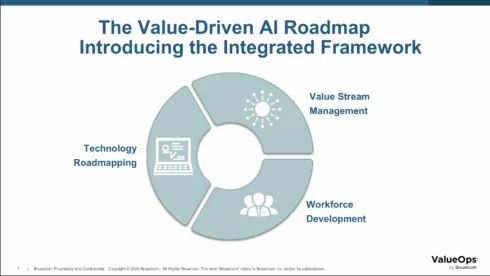
While the industry is racing to develop and implement artificial intelligence into its systems, cultural resistance, a skills gap, and the speed with which AI is changing are just a few of the factors why many AI projects fail.
Because of that, most attempts at adopting AI into organizations never make it past the pilot stage, according to Lance Knight, chief value stream architect at ValueOps by Broadcom. Part of the problem is that the technology that is supposed to make you more effective at speed and scale is itself changing all around you at the same time.
Machine learning and natural language processing have been understood and in use for quite some time now, but generative AI and the use of agents have taken it all to a different level. And because of that, C-suites are insisting their organizations need to adopt AI now, without even having a good plan in place for where it can be used to provide the most value. Nor, in many cases, do their current employees have the skills to best utilize the technology.
Yet many executives are simply demanding the use of AI, without, Knight said, “a whole lot more thought going into it than that. It’s the CIO or the board … saying we need AI. Let’s implement it today. And that’s not really the vetting and the understanding of how to get the most out of it.”
For instance, when training a large language model, it’s critical to have the right data and information fed into it, or else it’s not as useful as it could be. “The issue of data quality is a big one,” Knight said. “And data security is a big one as well. ‘How do I keep my stuff secure?’ And if you don’t really pay attention to the rules of that particular AI, you could put yourself at risk, because you’re training it and everyone else is using it.”
The Value-Driven AI Roadmap
ValueOps by Broadcom has created an AI roadmap so organizations can start to look at it “in the same way we used to look at managing a transformation or rolling something out… and make sure that it’s aligned to the value you hope to get out of it, connecting it to things like your OKRs,” Knight said.
There are three parts to the roadmap: value stream management, technology roadmapping and workforce development.
The use of value stream management helps organizations map their processes, identifying impediments to delivering software that has value, and using automation to collect metrics that give insights into those processes – and even anticipate where the next hurdles might pop up, Knight said. “I’m going to map the process out, look at where things are and say, hey, I could put an AI agent here, then create a program and a plan to do that in a technology roadmap to line up with it,” he explained.
Technology roadmapping involves aligning AI – what the organization is using now and what its needs might be a few years down the road – with business value. Staying on top of technology involves changes being driven by the market, the level of capability maturity within the organization, and finding where the gaps in your technology exist. “Roadmapping is more about helping organizations line up the change of different technologies and how to roll that out,” he said.
Finally, Knight pointed out, assessing the skills within your workforce, where training is needed, and how willing the workers are to change, is critical. “It’s about how people in the future, in organizations, will have AI agents that work for them. And you think about it having extra capabilities where I’m going to have this set of skills with these people, but I may have an agent that works for me,” Knight said. “Maybe that agent does paralegal work for me. And I have a specific agent that I work with to do that. People are going to become almost like these AI bosses. So when you’re thinking about capacity and planning and all of that, you have to incorporate those agents with that person that’s trying to understand how it is going to accomplish a task or goal in your value stream.”
A Blueprint for Implementing AI
Once assessment of your value streams has been used to find where AI can be adopted to remove process roadblocks, and skills training is underway, Knight discussed how organizations can plan, implement and evaluate how AI can best be utilized to maximize value. Then, he said, you’ll need to refine the implementation to help the organization achieve its goals.
This, he explained, is the work that organizations have done each time a transformation has been undertaken.
“You look at what you have, and you’re planning for something today and then you implement that, and it’s now three steps ahead of where you thought you were going to be,” he said. “And I think it’s going to be a time of constantly reviewing your system and reviewing what its capabilities are and then adjusting and tweaking as needed.”
But, Knight noted, it’s not something that you set up and then forget about it. “It’s just constantly going to be something that needs to be monitored,” he said. “Also there are different stages of organizations that will adopt this over time. There are companies that are on the bleeding edge of this … Microsoft, some of these other companies, they’re all in there making it all happen.”
He continued, “There’s another set of organizations that are slow to change. You don’t have to be on the bleeding edge to start to get advantages of setting up one or two agents and getting them into production. But in an organization, you can figure out how to use it in the right way. Maintaining governance, avoiding shadow AI. It’s really about that kind of thing as well.”Watch the complete webinar to learn more about the ValueOps by Broadcom AI roadmap.






